About Mon Repos Palace
Mon Repos Palace is a historic neoclassical building in the eastern part of Paleopolis, which is what Corfu’s ancient city is called.
The palace is situated on a hill overlooking the sea and was built as a summer residence for the British Commissioner of the Ionian Islands, Frederick Adam, in 1828, at the beginning of the peninsula of Kanoni opposite the ruins of Paleopolis. Though impressive, it falls short of the grandeur of the Achilleion Palace.
This structure was a gift from Sir Frederick Adam to his Corfiot wife, Nina Palatianos, reflecting his dedication to the Ionian Islands’ development, seen in various infrastructure projects he undertook.
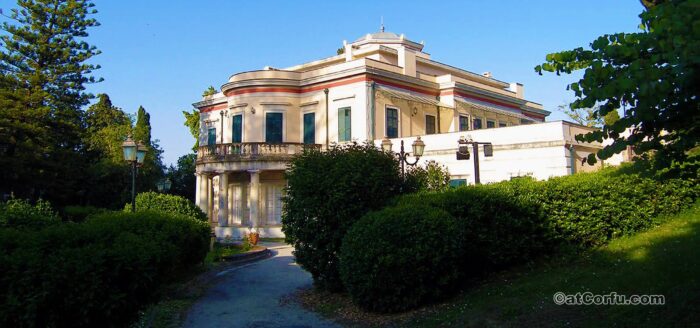

Later and throughout British rule, the palace was used as a summer residence for the commissioner in charge.
The Mon Repos estate covers an area of about 250 acres and includes a large garden with rare trees and plants, as well as a small lake. The palace itself is a neoclassical building with 12 rooms, which has been renovated and restored over the years.
Its well-laid-out gardens feature a variety of trees and plants, including palm trees, cypress trees, and eucalyptus trees, and are surrounded by the old Greek monuments of ancient Corfu and have spectacular sea views of the eastern coast of Corfu island, as well as a large pond with a small island in the center.
Source: https://en.wikipedia.org/wiki/Mon_Repos,_Corfu
Queen Elizabeth of Austria in Mon Repos
Queen Elizabeth of Austria, also known as the Sad Empress Sisi, stayed at Mon Repos Palace before commissioning the construction of the Achilleion Palace on the island of Corfu. It was during her stay at Mon Repos that she fell in love with the island and decided to build her palace there.
Empress Elizabeth, known as Sisi, was a frequent visitor to Corfu and often stayed at Mon Repos Palace. She was particularly fond of the gardens, which she found to be beautiful and peaceful. It was during her visits to Mon Repos that she became interested in Greek mythology and began to incorporate themes from Greek mythology into her own life and work.
Mon Repos and the former Greek royal family
According to the union treaty of the Ionian Islands with Greece, the building was to be given for use by the Greek royal family. Note: only to use it, not to own it.
And indeed, after the union with Greece in 1864, Mon Repos was used as their summer residence until the abolition of the Greek monarchy in 1973.
In 1974, after a referendum on the Greek Republic, the monarchy was definitively abolished, with 70% of the voters voting against the monarchy, and the alleged royal property was assigned to the Greek state.
Source: https://en.wikipedia.org/wiki/1974_Greek_republic_referendum
The former royal family appealed to European courts, considering this area and two others north of Athens as its property, but the European courts decided conclusively that the property now belongs to the Greek state and that the only thing the former royal family was entitled to was a small monetary compensation.
So the matter was closed once and for all. The Greek government considered the palace public property and turned it into a museum.
The palace is now open to the public as a museum.
The Gardens of Mon Repos
The gardens were designed by a team of British architects and landscape designers, including Sir Thomas Mawson, Edith Wharton, and Geoffrey Jellicoe, and were commissioned by the Greek royal family in 1819. The garden is located on a hill overlooking the Ionian Sea and covers an area of approximately 258 acres.
The gardens are divided into several sections, each with its unique features. One of the most notable features is the Pinewood Garden, which features a dense forest of pine trees that provides a cool respite from the hot summer sun. Another notable section is the Garden of the Nine Muses, which features nine statues of the muses, each with a different instrument or attribute.
Other sections of the garden include the Palm Garden, the Rose Garden, and the English Garden. The gardens also contain several buildings, including the Mon Repos Palace, which was built in the neoclassical style and served as a summer residence for the Greek royal family.
Today, the Gardens of Mon Repos Palace are open to the public and are a popular destination for tourists visiting Corfu. Visitors can stroll through the gardens, explore the various sections, and learn about the history of the palace and the royal family that once resided there.
The wide area of Paleopolis, Corfu


Paleopolis is the ancient city of Corfu, and it is considered one of the most important archaeological sites on the island. The site covers a wide area and includes several important historical and cultural landmarks.
The city was founded in the 8th century BC by the Corinthians and was an important center of trade and commerce in the ancient world. Today, the archaeological site of Paleopolis covers an area of approximately 20,000 square meters and includes several important landmarks, such as the Temple of Hera, the Temple of Artemis, and the Sanctuary of Kardaki. Mon Repos Palace is inside the wide area of Paleopolis in the Eastern part.
More about Paleopolis
Is Mon Repos the birthplace of the Duke of Edinburgh, Phillip?
Prince Philip, the Duke of Edinburgh, was born in Mon Repos Palace in Corfu on June 10, 1921. He was born into the Greek and Danish royal families as Prince Philip of Greece and Denmark and was the fifth child and only son of Prince Andrew of Greece and Denmark and Princess Alice of Battenberg.
At the time of his birth, Greece was a constitutional monarchy, and Prince Philip’s grandfather, King George I of Greece, was the reigning monarch. However, the family was forced to flee Greece when Prince Philip was just a baby due to political turmoil in the country.
After leaving Greece, the family settled in Paris, and Prince Philip was later sent to school in England. He eventually joined the British Royal Navy and served in World War II before marrying Queen Elizabeth II in 1947 and becoming the Duke of Edinburgh.
Despite being born in Greece, Prince Philip spent very little time there and was primarily raised and educated in England. However, he maintained a strong connection to his Danish heritage throughout his life, but never visited Greece. He even denied his Greek identity.
Bolovini Eleni, a historian writes about the strange life of Pince Philip and why he denied his Greek identity.
(Greek: Η πραγματικά παράξενη ζωή του πρίγκιπα Φιλίππου, πατέρα του Καρόλου -Γιατί απαρνήθηκε την ελληνική ταυτότητά του)
Source: : iefimerida.gr – https://www.iefimerida.gr/news/415189/i-pragmatika-paraxeni-zoi-toy-prigkipa-filippoy-patera-toy-karoloy-giati-aparnithike-tin
Mon Repos Corfu as a Museum


Today, Mon Repos Palace belongs to the Greek state, and it is used by the Municipality of Corfu, mainly for authoritative or festive meetings.
Mon Repos has been transformed into a museum and a historic place with a large park full of archaeological treasures that can be visited by all.
Inside the palace, there are exhibits showcasing the history of the palace and the island of Corfu, as well as displays of art and artifacts. The palace also hosts cultural events and exhibitions throughout the year.
It is an ideal place for pleasant walks under the shade of very large and old trees.
One of the museum’s most interesting exhibitions is the collection of old Corfu photographs, most interesting and informative.
This museum is open to the public on weekdays from 8 am to 7 pm for a small fee of 4€, while there is usually no charge on weekends.
Also, you can buy a combined ticket that includes visits to Mon Repos, the Asian Museum of Art in Corfu town, Achilleion Palace, and some other places simultaneously.
There are buses connecting Paleopolis with Corfu town every 40 minutes, but the distance is small and can be covered on foot in just 15 minutes.
The telephone number for further details is +30 26610 41369.
Wrapping Up
Today, Mon Repos Palace is open to the public and is a popular tourist destination on the island of Corfu. Visitors can explore the palace and its beautiful gardens, as well as learn about the history of the palace and the Greek royal family that once resided there.






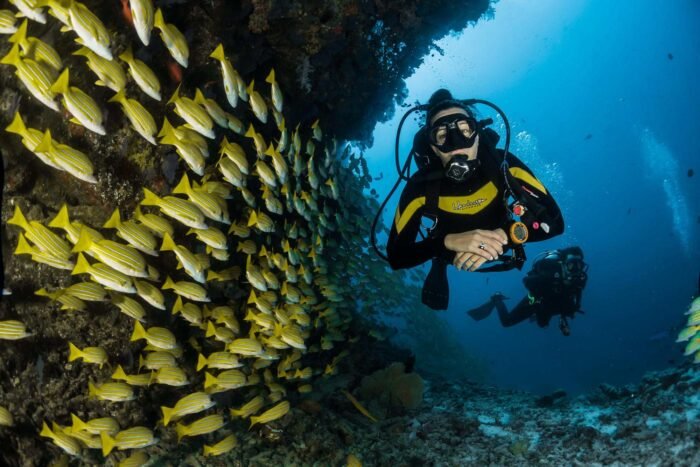


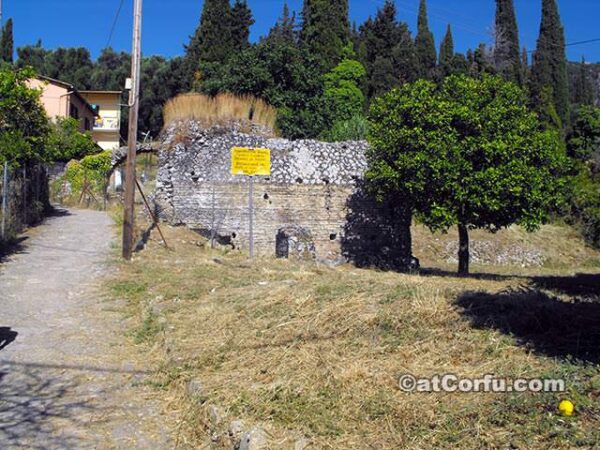

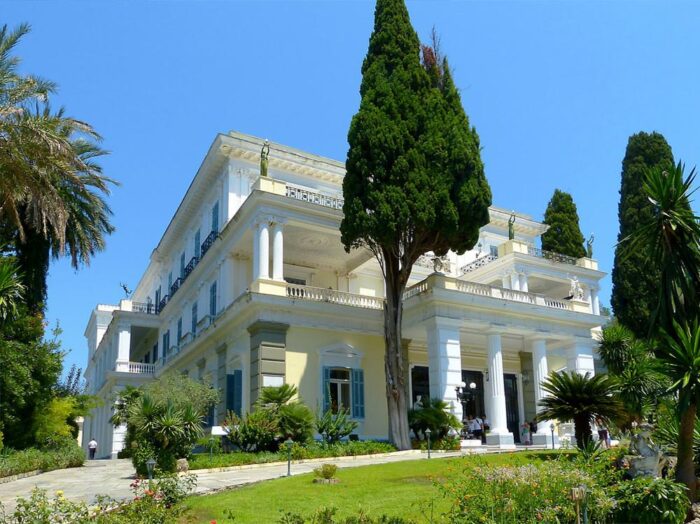

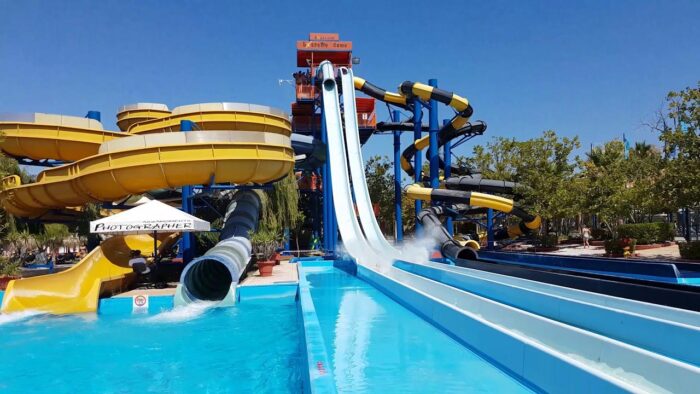

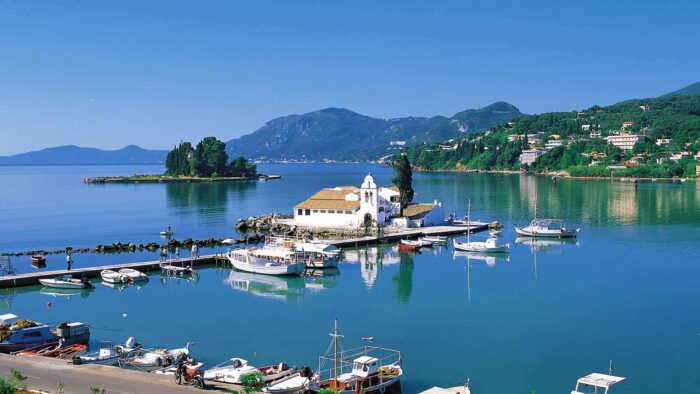

Comments